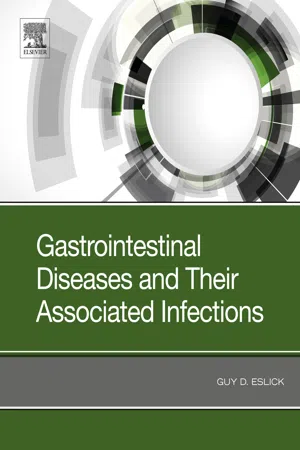
- 400 pages
- English
- ePUB (mobile friendly)
- Available on iOS & Android
Gastrointestinal Diseases and Their Associated Infections
About this book
Many bacteria, viruses, protozoa, and fungi play key roles in the development of gastrointestinal diseases, and this practical reference brings you up to speed with this increasingly important area. Covering a broad range of GI diseases and cancers, this resource provides an expert overview of the field, ideal for all gastroenterologists and infectious disease physicians.- Covers infections associated with gastroesophageal reflux disease and Barrett's esophagus, gallbladder disease, acute pancreatitis, small intestinal bacterial overgrowth, irritable bowel syndrome, inflammatory bowel disease, appendicitis, Whipple Disease, Crohn's Disease, and more.- Discusses esophageal cancer, gastric cancer, cholangiocarcinoma, hepatocellular carcinoma, and colorectal cancer.- Includes chapters on gut microbiome, fecal transplants, and the molecular pathgenesis of gastrointestinal infections.- Consolidates today's available information on this timely topic into a single convenient resource.
Frequently asked questions
- Essential is ideal for learners and professionals who enjoy exploring a wide range of subjects. Access the Essential Library with 800,000+ trusted titles and best-sellers across business, personal growth, and the humanities. Includes unlimited reading time and Standard Read Aloud voice.
- Complete: Perfect for advanced learners and researchers needing full, unrestricted access. Unlock 1.4M+ books across hundreds of subjects, including academic and specialized titles. The Complete Plan also includes advanced features like Premium Read Aloud and Research Assistant.
Please note we cannot support devices running on iOS 13 and Android 7 or earlier. Learn more about using the app.
Information
The Esophageal Microbiome
Esophageal Reflux Disease, Barrett’s Esophagus, and Esophageal Cancer
Abstract
Keywords
Infections of the Esophagus
Infective Esophagitis
Chagas Disease or American Trypanosomiasis


Gastroesophageal Reflux Disease
Introduction
Table of contents
- Cover image
- Title page
- Table of Contents
- Copyright
- Dedication
- List of Contributors
- Preface
- Chapter 1. The Esophageal Microbiome: Esophageal Reflux Disease, Barrett’s Esophagus, and Esophageal Cancer
- Chapter 2. Helicobacter pylori, Peptic Ulcer Disease and Gastric Cancer
- Chapter 3. The Role of Infections and the Microbiome in Gallbladder Diseases
- Chapter 4. Hepatitis B Virus, Hepatitis C Virus, the Microbiome, and Hepatocellular Carcinoma
- Chapter 5. Infectious Causes of Acute Pancreatitis
- Chapter 6. Clinical Conditions Associated With Bacterial Overgrowth
- Chapter 7. Infections Associated With Irritable Bowel Syndrome
- Chapter 8. Appendicitis and Infections of the Appendix
- Chapter 9. Infectious Organisms Associated With Colorectal Cancer
- Chapter 10. Infections and Pancreatic Cancer
- Chapter 11. Viral Gastroenteritis
- Chapter 12. Bacterial Gastroenteritis
- Chapter 13. Molecular Diagnosis of Gastrointestinal Infections
- Chapter 14. Tropheryma Whipplei Agent of Self-Limiting Infections and Whipple’s Disease
- Chapter 15. Celiac Disease: Autoimmunity, Infectious Links, and the Microbiome
- Chapter 16. Parasitic Diarrhea
- Chapter 17. Hirschsprung-Associated Enterocolitis
- Chapter 18. Fecal Microbiota Transplantation: Treatment of the Gut Microbiome
- Index